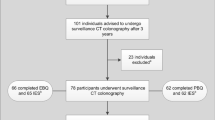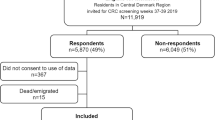Abstract
Objective: The aim of this study was to see whether individuals who perceive their risk for developing colorectal cancer (CRC) as lower than average are found to be at lower risk as determined by findings at flexible sigmoidoscopy (FS) screening. Methods: Participants (n = 10,551) were men and women aged 55–64 years from a subset of participants in the UK FS Trial. Self-report questionnaires assessed perceived comparative risk of developing bowel cancer prior to participants being invited to attend FS screening. Objective risk was judged from polyp status during the FS test. Results: A very modest relationship was found between risk judgments and actual risk with 77% of ‘optimists’ having negative findings compared to 71% of ‘pessimists’. More pessimists (14%) had an adenoma compared to optimists (11%). Compared to pessimists the odds of optimists actually being at lower risk of CRC equaled 0.70 (0.57, 0.86). Conclusions: The results suggest that people may have a limited ability to assess their risk of developing CRC. Health professionals should not assume that individuals have an accurate perception of their risk for cancer. Increasing people's ability to accurately perceive their risk may encourage more appropriate cancer preventive behavior.
Similar content being viewed by others
References
Codori AM, Petersen GM, Miglioretti DL, Boyd P (2001) Health beliefs and endoscopic screening for colorectal cancer: potential for cancer prevention. Prev Med 33: 128-136.
Macrae FA, Hill DJ, St John DJ, Ambikapathy A, Garner JF (1984) Predicting colon cancer screening behavior from health beliefs. Prev Med 13: 115-126.
McCaul KD, Branstetter AD, Schroeder DM, Glasgow RE (1996) What is the relationship between breast cancer risk and mammography screening? A meta-analytic review. Health Psychol 15: 423-429.
Myers RE, Vernon SW, Tilley BC, Lu M, Watts BG (1998) Intention to screen for colorectal cancer among white male employees. Prev Med 27: 279-287.
Wardle J, Sutton S, Williamson S, et al. (2000) Psychosocial influences on older adults’ interest in participating in bowel cancer screening. Prev Med 31: 323-334.
Aiken LS, Fenaughty AM, West SG, Johnson JJ, Luckett TL (1995) Perceived determinants of risk for breast cancer and the relations among objective risk, perceived risk, and screening behavior over time. Womens Health 1: 27-50.
Lipkus IM, Rimer BK, Strigo TS (1996) Relationships among objective and subjective risk for breast cancer and mammography stages of change. Cancer Epidemiol Biomarkers Prev 5: 1005-1011.
Woloshin S, Schwartz LM, Black WC, Welch HG (1999) Women's perceptions of breast cancer risk: how you ask matters. Med Decis Making 19: 221-229.
Lipkus IM, Rimer BK, Lyna PR, Pradhan AA, Conaway M, Woods-Powell CT (1996) Colorectal screening patterns and perceptions of risk among African-American users of a community health center. J Community Health 21: 409-427.
Weinstein ND (1980) Unrealistic optimism about future life events. J Pers Soc Psychol 39: 806-820.
Peterson C, Bossio LM (2001) Optimism and Physical Well-Being. In: Chang EC, ed. Optimism and pessimism: Implications for theory, research, and practice. Washington: American Psychological Association, pp. 127-145.
Colditz GA, Atwood KA, Emmons K, et al. (2000) Harvard report on cancer prevention volume 4: Harvard Cancer Risk Index. Cancer Causes Control 11: 477-488.
Weinstein ND, Atwood KA, Puleo E, Fletcher RH, Colditz GA, Emmons K (in press) Colon cancer: risk perceptions and risk communication. J Health Commun.
Kreuter MW, Strecher VJ (1995) Changing inaccurate perceptions of health risk: results from a randomized trial. Health Psychol 14: 56-63.
McKenney JL, Lapane KL, Assaf AR, Carleton RA (1995) The association between perceived risk and actual cardiovascular disease. Epidemiology 6: 612-616.
Dave S, Hui S, Kroenke K, Imperiale TF (2003) Is the distal hyperplastic polyp a marker for proximal neoplasia? J Gen Intern Med 18: 128-137.
Atkin W, Edwards R, Wardle J, et al. (2001) Design of a multicentre randomised trial to evaluate flexible sigmoidoscopy in colorectal cancer screening. J Med Screen 8: 137-144.
Atkin WS (2002) Single flexible sigmoidoscopy screening to prevent colorectal cancer: baseline findings of a UK multicentre randomised trial. Lancet 359: 1291-1300.
Weinstein ND (1987) Unrealistic optimism about susceptibility to health problems: conclusions from a community-wide sample. J Behav Med 10: 481-500.
Kaplan GA, Camacho T (1983) Perceived health and mortality: a nine-year follow-up of the human population laboratory cohort. Am J Epidemiol 117: 292-304.
Idler EL, Benyamini Y (1997) Self-rated health and mortality: a review of twenty-seven community studies. J Health Soc Behav 38: 21-37.
Author information
Authors and Affiliations
Corresponding author
Rights and permissions
About this article
Cite this article
Robb, K.A., Miles, A. & Wardle, J. Subjective and objective risk of colorectal cancer (UK). Cancer Causes Control 15, 21–25 (2004). https://doi.org/10.1023/B:CACO.0000016567.82368.6c
Issue Date:
DOI: https://doi.org/10.1023/B:CACO.0000016567.82368.6c




